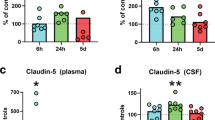Abstract
The formation and functional plasticity of the blood–brain barrier are inextricably linked to the molecular events occurring in cerebral neurovascular unit during the embryonic and early postnatal development of the organism. To study the features of the barrier genesis under physiological conditions, as well as after perinatal hypoxia and stress in early life, tight junction proteins of cerebral endothelial cells (the number of JAM-, ZO1-, and CLDN5-positive cells) in rats at the age of 7 (P7), 28 (P28), and 70 (P70) days were investigated. It was found that, under physiological conditions, the number of cells expressing JAM, ZO1, and CLDN5 slightly increase in the period from P7 to P70 in the cortex, hippocampus, and amygdala of the brain. After perinatal hypoxia, the number of cells expressing the proteins of tight junctions (JAM, CLDN5) is significantly increased to the age of P28–P70, while the number of ZO1+ cells in the same period of time is reduced. Early life stress causes an imbalance between the expression of ZO1 and other proteins of tight junctions, but these changes are opposite in direction.
Similar content being viewed by others
Abbreviations
- CLDN5:
-
claudin-5 (a protein of tight junctions)
- JAM:
-
junctional adhesion molecule
- ZO1:
-
zonula occludens 1 (a protein of tight junctions)
- BBB:
-
blood-brain barrier
References
Bauer, H.C., Krizbai, I.A., Bauer, H., and Traweger, A., “You shall not pass”—tight junctions of the blood brain barrier, Front Neurosci., 2014, vol. 8, p. 392. doi 10.3389/fnins.2014.00392
Bernier, P.J., Bedard, A., Vinet, J., Levesque, M., and Parent, A., Newly generated neurons in the amygdala and adjoining cortex of adult primates, Proc. Natl. Acad. Sci. USA., 2002, vol. 99, pp. 11464–11469.
Biron, K.E., Dickstein, D.L., Gopaul, R., and Jefferies, WA., Amyloid triggers extensive cerebral angiogenesis causing blood brain barrier permeability and hypervascularity in Alzheimer’s disease, PLoS One, 2011, vol. 6, p. e23789. doi 10.1371/journal.pone.0023789
Bueno, D., Parvas, M., Hermelo, I., and Garcia-Fernàndez, J., Embryonic blood-cerebrospinal fluid barrier formation and function, Front. Neurosci., 2014, vol. 8, p. 343. doi 10.3389/fnins.2014.00343
Cioni, G., D’Acunto, G., and Guzzetta, A., Perinatal brain damage in children: neuroplasticity, early intervention, and molecular mechanisms of recovery, Prog. Brain Res., 2011, vol. 189, pp. 139–154. doi 10.1016/B978-0-444-53884-0.00022-1
Clancy, B., Finlay, B.L., Darlington, R.B., and Anand, K.J., Extrapolating brain development from experimental species to humans, Neurotoxicology, 2007, vol. 28, pp. 931–937.
Ebnet, K., Aurrand-Lions, M., Kuhn, A., Kiefer, F., Butz, S., Zander, K., Meyer, zu, Brickwedde, M.K., Suzuki, A., Imhof, B.A., and Vestweber, D., The junctional adhesion molecule (JAM) family members JAM-2 and JAM-3 associate with the cell polarity protein PAR-3: a possible role for JAMs in endothelial cell polarity, J. Cell Sci., 2003, vol. 116, pp. 3879–3891.
Ek, C.J., Dziegielewska, K.M., Habgood, M.D., and Saunders, N.R., Barriers in the developing brain and neurotoxicology, Neurotoxicology, 2012, vol. 33, pp. 586–604. doi 10.1016/j.neuro.2011.12.009
Enerson, B.E. and Drewes, L.R., The rat blood-brain barrier transcriptome, J. Cereb. Blood Flow. Metab., 2006, vol. 26, pp. 959–973.
Fan, Q.Y., Ramakrishna, S., Marchi, N., Fazio, V., Hallene, K., and Janigro, D., Combined effects of prenatal inhibition of vasculogenesis and neurogenesis on rat brain development, Neurobiol. Dis., 2008, vol. 32, pp. 499–509. doi 10.1016/j.nbd.2008.09.007
Gómez-González, B. and Escobar, A., Prenatal stress alters microglial development and distribution in postnatal rat brain, Acta Neuropathol., 2010, vol. 119, pp. 303–315. doi 10.1007/s00401-009-0590-4
Jiao, H., Wang, Z., Liu, Y., Wang, P., and Xue, Y., Specific role of tight junction proteins claudin-5, occludin, and ZO1 of the blood-brain barrier in a focal cerebral ischemic insult, J. Mol. Neurosci., 2011, vol. 44, pp. 130–139. doi 10.1007/s12031-011-9496-4
Nylander, I. and Roman, E., Neuropeptides as mediators of the early-life impact on the brain; implications for alcohol use disorders, Front Mol. Neurosci., 2012, vol. 5, p. 77. doi 10.3389/fnmol.2012.00077
Oreland, S., Nylander, I., and Pickering, C., Prolonged maternal separation decreases granule cell number in the dentate gyrus of 3-week-old male rats, Int. J. Dev. Neurosci., 2010, vol. 28, pp. 139–144. doi 10.1016/j.ijdevneu.2009.12.005
Rice, J.E., 3rd, Vannucci, R.C., and Brierley, J.B., The influence of immaturity on hypoxic-ischemic brain damage in the rat, Ann. Neurol., 1981, vol. 9, pp. 131–141.
Saunders, N.R., Liddelow, S.A., and Dziegielewska, K.M., Barrier mechanisms in the developing brain, Front Pharmacol., 2012, vol. 46. doi 10.3389/fphar.2012.00046
Siegenthaler, J.A., Sohet, F., and Daneman, R., ‘Sealing off the CNS’: cellular and molecular regulation of bloodbrain barriergenesis, Curr. Opin. Neurobiol., 2013, vol. 23, pp. 1057–1064. doi 10.1016/j.conb.2013.06.006
Uhelski, M.L. and Fuchs, P.N., Maternal separation stress leads to enhanced emotional responses to noxious stimuli in adult rats, Behav. Brain Res., 2010, vol. 212, pp. 208–212. doi 10.1002/dev.20559
Wallace, C.S., Withers, G.S., Farnand, A., Lobingier, B.T., and McCleery, E.J., Evidence that angiogenesis lags behind neuron and astrocyte growth in experience-dependent plasticity, Dev. Psychobiol., 2011, vol. 53, pp. 435–442.
Wen, J., Qian, S., Yang, Q., Deng, L., Mo, Y., and Yu, Y., Overexpression of netrin-1 increases the expression of tight junction-associated proteins, claudin-5, occludin, and ZO1, following traumatic brain injury in rats, Exp. Ther. Med., 2014, vol. 8, pp. 881–886.
Zhang, Q., Ding, Y., Yao, Y., Yu, Y., Yang, L., and Cui, H., Creating rat model for hypoxic brain damage in neonates by oxygen deprivation, PLoS One, 2013, vol. 8, p. e83589. doi 10.1371/journal.pone.0083589
Author information
Authors and Affiliations
Corresponding author
Additional information
Original Russian Text © N.V. Kuvacheva, A.V. Morgun, N.A. Malinovskaya, Y.V. Gorina, E.D. Khilazheva, E.A. Pozhilenkova, Y.A. Panina, E.B. Boytsova, V.A. Ruzaeva, L.V. Trufanova, A.B. Salmina, 2016, published in Tsitologiya, 2016, Vol. 58, No. 5, pp. 364–369.
Rights and permissions
About this article
Cite this article
Kuvacheva, N.V., Morgun, A.V., Malinovskaya, N.A. et al. Tight junction proteins of cerebral endothelial cells in early postnatal development. Cell Tiss. Biol. 10, 372–377 (2016). https://doi.org/10.1134/S1990519X16050084
Received:
Published:
Issue Date:
DOI: https://doi.org/10.1134/S1990519X16050084




